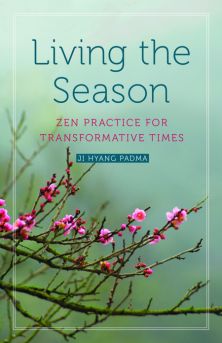 All of us change after college. Some of us, for example, head off to seminary with the intention of becoming a Presbyterian minister and then graduate several years later, neither Presbyterian nor a minister.
All of us change after college. Some of us, for example, head off to seminary with the intention of becoming a Presbyterian minister and then graduate several years later, neither Presbyterian nor a minister.
Not that I’m speaking autobiographically or anything.
But I’m not the only member of my college class who made a significant religious shift after Commencement. A classmate I knew as Bridget has, for many years, been known as Ji Hyang Padma, a Buddhist teacher in the Korean Zen tradition. She spent fifteen years as a Buddhist nun, headed up the Cambridge Zen Center for a time, and has taught workshops at Esalen, Kripalu, UCLA and other places.
And now she’s written a book: Living the Season: Zen Practice for Transformative Times. [tweetable]It’s an introduction to meditation for people who are attracted to the serenity they sense in Buddhism but are intimidated by the actual “practice” part of practicing Zen.[/tweetable]
In it she describes her own initial foray into Zen Buddhism, which started through her college practices of aikido and shiatsu. “My greatest mentors in shiatsu and aikido had active meditation practices,” she explains, which made her want to try meditation too. After college she took up residence at a Zen center and devoted herself to meditation and compassionate action.
 That spirit of compassion pervades the book she’s written, which aims to help people like me with little or no meditation experience begin on the path. If you’ve read Flunking Sainthood, you’ll know that the practices I failed most miserably were the contemplative ones, especially Centering Prayer, which has many things in common with meditation. I sucked at it, to tell the truth. So I appreciate compassion a great deal, as do many people who try meditation or contemplation and then beat themselves up for not getting it “right,” and not progressing quickly enough. It’s hard to remember that these are practices for a lifetime.
That spirit of compassion pervades the book she’s written, which aims to help people like me with little or no meditation experience begin on the path. If you’ve read Flunking Sainthood, you’ll know that the practices I failed most miserably were the contemplative ones, especially Centering Prayer, which has many things in common with meditation. I sucked at it, to tell the truth. So I appreciate compassion a great deal, as do many people who try meditation or contemplation and then beat themselves up for not getting it “right,” and not progressing quickly enough. It’s hard to remember that these are practices for a lifetime.
The book is organized in a wise and beautiful way around the seasons of the year, each of which has a gift to offer on the road to understanding.
- Winter: Finding light in the darkness
- Spring: New life beginning
- Summer: The blossoming of true nature
- Autumn: Everything changes
There are simple exercises (walking meditation, sky gazing, even cleaning the house) to heighten awareness and train the mind in its ability to “rest in the present moment,” as Ji Hyang puts it.
And she reminds the reader often that [tweetable]it’s not perfection we’re after, some ideal final state of nirvana, so much as the “journey to wholeness” itself.[/tweetable] The means are the end and not merely the ways to get to the end. Keep a “try mind” and “give yourself completely to this moment.”





